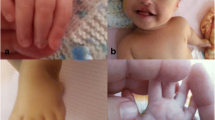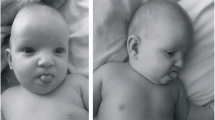Summary
Thirteen new cases of a pericentric inversion 2 collected from different laboratories are reported. In addition 41 cases of a pericentric inversion 2 were reviewed from the literature. The pooled data were analysed using Weinberg's proband method to evaluate the risk of a carrier for either children with congenital anomalies or reproductive wastage. In the “corrected” sample of 166 lifeborn offspring of carriers of a pericentric inversion 2 there were five who showed phenotypic anomalies and two died a few hours after delivery. The reported anomalies are heterogeneous and probably reflect the basic risk of any couple for abnormal lifeborn offspring. There has been no observation of a lifeborn who inherited an unbalanced recombination of a parental pericentric inversion 2. A carrier of a pericentric inversion 2 obviously has an increased risk for reproductive wastage. This is indicated by (1) an increase of the rate of spontaneous abortions and (2) an increase of the rate of index patients ascertained because of previous miscarriages. The risk of a carrier of a pericentric inversion 2 for a spontaneous abortion or a stillbirth may be about twice the basic risk of the general population.
Similar content being viewed by others
References
Ayme S, Mattei MG, Mattei JF, Giraud F (1979) Abnormal childhood phenotypes associated with the same balanced chromosome rearrangements as in the parents. Hum Genet 48:7–12
Baccichetti C, Lenzini E, Peserico A, Tenconi R (1980) Study on segregation and risk for abnormal offspring in carriers of pericentric inversion of the (p11→q13) segment of chromosome 2. Clin Genet 18:402–407
Barbi G, Steinbach P, Vogel W (1984) Nonrandom distribution of methotrexate-induced aberrations on human chromosomes. Detection of further folic acid sensitive fragile sites. Hum Genet 68:290–294
Boué J, Boué A (1978) Prenatal diagnosis in 100 structural rearrangements of the chromosomes. Cytogenet Cell Genet 20:213–225
Carr DH (1962) Chromosome anomalics with special reference to Klinefelter's syndrome. Trans Am Assoc Genitourin Surg 54:9
Cohen MM, Capraro VJ (1967) Pericentric inversion in a group D chromosome (13–15) associated with amenorrhea and gonadal dysgenesis. Ann Hum Genet 30:313
Cohen MM, Rosenmann A, Hacham-Zadeh S, Dahan S (1975) Dicentric X-isochromosome (Xqidic) and pericentric inversion of No. 2 inv(2)(p15q21) in a patient with gonadal dysgenesis. Clin Genet 8:11–17
de Grouchy J, Emerit I, Corone P, Vernant P, Lamy M, Soulie P (1963) Inversion pericentric probable du chromosome No.2 et malformations congenitales chez un garcon. Ann Genet (Paris) 6:21–23
de Grouchy J, Aussannaire M, Brissaud HE, Lamy M (1966) Aneusomie de recombinaison: three further examples. Am J Hum Genet 18:467–483
Djalali M, Barbi G, Steinbach P (1985) Folic acid sensitive fragile sites are not limited to the human karyotype. Demonstration of nonrandom gaps and breaks in the Persian vole Ellobius lutescens Th. inducible by methotrexate, fluorodeoxyuridine, and aphidicolin. Hum Genet 70:183–185
Fryns JP, Petit P, Heffinck R, van den Berghe H (1983) Mosaic pericentric inversion of chromosome 2. J Genet Hum 31:157–161
Hecht F, Hecht BK (1984) Fragile sites and chromosome breakpoints in constitutional rearrangements. II. Spontaneous abortions, stillbirths and newborns. Clin Genet 26:174–177
Hesselbjerg U, Friedrich U (1979) Pericentric inversion in chromosome No. 2 as a de novo mutation. Hum Genet 53:117–119
Hooft C, Coetsier H, Orye E (1968) Syndrome de Turner et inversion pericentrique probable du chromosome No. 2. Ann Genet (Paris) 11:181–183
Jacobs PA, Melville M, Ratcliffe S (1974) A cytogenetic survey of 11,680 newborn infants. Ann Hum Genet 37:359–376
Leonard C, Hazael-Massieux P, Bocquet L, Larget-Piet L, Boue J (1975) Inversion pericentrique inv(2)(p11q13) dans des familles non apparentées. Hum Genet 28:121–128
Mattevi MS, Pinheiro CEA, Erdtmann B, Flores RZ, Salzano FM (1981) Familial pericentric inversion of chromosome 2. J Genet Hum 29:161–169
McDonald IM, Cox DM (1985) Inversion of chromosome 2(p11q13). Frequency and implications for genetic counselling. Hum Genet 69:281–283
Nielsen J, Sillesen I (1975) Incidence of chromosome aberrations among 11,148 newborn children. Hum Genet 30:1–12
Phillips RB (1978) Pericentric inversions inv(2)(p11q13) and inv(2)(p13q11) in 2 unrelated families. J Med Genet 15:388–390
Podugolńikova OA, Blyumina MG (1972) Pericentric inversion of chromosome 2 in a girl with congenital mental deficiency and in her mother. Genetika (Moskva) 8:156–161
Romain DR, Chapman CJ, Columbano-Green C, Smythe RH, Gebbie O (1982) Two pericentric inversions, inv(2)(p11q13) and inv(5)(p13q13), in a patient referred for psychiatric problems. J Med Genet 19:153–155
Singh RP, Jaco NT, Vigna MV (1970) Pierre Robin syndrome in siblings. Am J Dis Child 120:560–561
Steinbach P, Djalali M (1983) Ineffectively of accessory bisatellited marker chromosomes in inducing meiotic nondisjunction. Hum Genet 64:402–403
Steinbach P, Adkins WN, Caspar JRH, Dumars KW, Gebauer J, Gilbert EF, Grimm T, Habedank M, Hansmann I, Herrmann J, Kaveggia EG, Langenbeck U, Meisner LF, Najafzadeh TM, Opitz JM, Palmer CG, Peters HH, Scholz W, Tavares AS, Wiedeking C (1981) The dup (3q) syndrome. Am J Med Genet 10:159–177
Steinbach P, Djalali M, Hansmann I, Kattner E, Meisel-Stosiek M. Probeck HD, Schmidt A, Wolf M (1983) The genetic significance of accessory bisatellited marker chromosomes. Hum Genet 65:155–164
Stern C (1973) Principles of human genetics, 3rd edn. Freeman, San Francisco
Subrt I, Kozak J, Hnikova O (1973) Microdensitmetric identification of the pericentric inversion of chromosome No. 2 and of duplication of the short arm of chromosome No. 7 in a reexamined case. Hum Hered 23:331–337
Summitt RL, Atnip RL (1966) Chromosomal aberrations with normal phenotype: four examples. Acta J Med Sci 3:483
Vejerslev LO, Friedrich U (1984) Experiences with unexpected structural chromosome aberrations in prenatal diagnosis in a Danish series. Prenat Diagn 4:181–186
Verma RS, Dosik H, Wexler IB (1977) Inherited pericentric inversion of chromosome No. 2 with Robertsonian translocation (13q14q) resulting in trisomy for chromosome 13q. J Genet Hum 25:295–301
Weitkamp LR, Janzen MK, Guttormsen SA, Gershowitz H (1969) Inherited pericentric inversion of chromosome number two: a linkage study. Ann Hum Genet 33:53
Wikramanayake E, Renwick JH, Ferguson-Smith MA (1971) Chromosomal heteromorphisms in the assignment of loci to particular autosomes: a study of four pedigrees. Ann Genet (Paris) 14:245–256
Author information
Authors and Affiliations
Rights and permissions
About this article
Cite this article
Djalali, M., Steinbach, P., Bullerdiek, J. et al. The significance of pericentric inversions of chromosome 2. Hum Genet 72, 32–36 (1986). https://doi.org/10.1007/BF00278814
Received:
Revised:
Issue Date:
DOI: https://doi.org/10.1007/BF00278814




